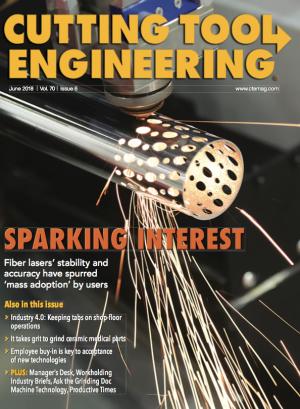
Improving productivity has long been a shared goal of manufacturers.
A few decades ago, the desire to improve productivity led to innovations like the automatic screw machine, digital readouts and CNC machining. And more recently, we have seen innovations like part probes, automated tool setting and machine tool monitoring.
The use of many modern technologies has become so widespread that machinists, toolmakers and engineers no longer consider them new or advanced. As examples, all machine tool builders now offer probes, tool-setting devices, USB ports and monitoring software as options; some high-end builders even include these as standard features. Almost any CNC machinist or manufacturing engineer can quickly detail the productivity advantages associated with the use of such devices.
Despite the advantages, though, it is common to find shops where productivity-enhancing technologies are not universally embraced.
Why is this? Because of poor or incomplete integration of a technology into a manufacturing process. The addition of capabilities and devices to a manufacturing system requires that all the components—old and new—mesh seamlessly. Improper installation or a painful integration of a new technology can leave a negative, indelible impression on shop personnel and engineers, giving rise to mistrust and apathy. These, in turn, can lead to complete rejection or underutilization of a new technology.
Automotive machining is a prime example. Large auto-parts manufacturers have controlled, highly reliable, mature machining processes with little or no variation. Addition of a new or different device intended to enhance productivity, for instance, can create a system that deviates from what is familiar and reliable, resulting in a device going unused.
To ensure success, shops and other manufacturers must understand and take into account the four main areas of the technology acquisition process: problem definition, conceptualization, implementation and realization.
Define the Problem
The purchase and implementation of a productivity-enhancing technology should be preceded by analysis of the entire manufacturing process, with the goal being a clear understanding of the problem or problems.
Where are productivity losses occurring? Do setups take too long? Do inspection and data collection inhibit the flow of parts? Does tool wear interrupt production or cause quality issues? Is there a combination of issues in which one is exacerbated by others?
In every situation, implementation requires an accurate definition of the problem.
Conceptualize the Effects
Once the problem is clearly defined, solutions can be researched and selected for trial. Understanding that even the simplest machining operations occur in a system, it is necessary to conceptualize how proposed changes will affect the manufacturing process.
As an example, consider the addition of a tool presetter to a machining center. How would this impact the program structure? Would the machinist call the programs for tool setting, or would the codes be contained in the part programs? How often would cutting tools be measured? Each time they are used or just when they are replaced? What happens when tool dimensions deviate from allowable limits?
These are the types of questions that must be answered before implementing a change in the manufacturing process.
Implement the Plan
Bringing a new technology online should be performed by trustworthy experts. Attempts to trim costs or improve delivery with do-it-yourself installations should be avoided. Poor installations not only can destroy expensive electronic devices, like probes, but can lead to expensive machine tool repairs, such as when a machine acts on bad data transmitted by a new probe or an expensive board is toasted when the wrong wires are connected.
Implementation should be deliberate, which means establishing a plan that addresses all critical questions raised during the conceptualization phase. Each question should be addressed during implementation.
Returning to the tool setter example, let’s say a setter has been selected, it has been determined that tools should be measured before each use and the machine utilizes more than 100 programs—20 of which are used regularly. Those 20 will be changed as part of the implementation program by adding a subprogram call at each tool change.
Planning and setting goals for implementation ensure that each step is clearly defined and aligned to the problem.
Assess the Results
Realization is the last step when integrating technology into a manufacturing process. Were the desired results realized? Yes or no? Why or why not? Were things overlooked during conceptualization?
It is almost guaranteed that unforeseen problems will arise when manufacturing processes are changed. Success requires resolving issues that prevent the system from functioning as planned. Meeting all expectations set forth during the conceptualization phase instills confidence, thereby reducing the possibility of reversion to old practice.
Parts manufacturers will continue to seek technologies and devices that improve productivity. Survival in the modern manufacturing market requires all enterprises to seek productivity improvements. Those that adopt and implement productivity-enhancing technology will move forward. Those that fail to do so will fall behind.
Related Glossary Terms
- automatic screw machine
automatic screw machine
Turning machine designed to produce parts automatically from coil or bar stock. The two basic types are cam (mechanical) and programmable (computer-controlled). Usually single-spindle, but Swiss types often have multiple spindles. See lathe; turning machine.
- computer numerical control ( CNC)
computer numerical control ( CNC)
Microprocessor-based controller dedicated to a machine tool that permits the creation or modification of parts. Programmed numerical control activates the machine’s servos and spindle drives and controls the various machining operations. See DNC, direct numerical control; NC, numerical control.
- machining center
machining center
CNC machine tool capable of drilling, reaming, tapping, milling and boring. Normally comes with an automatic toolchanger. See automatic toolchanger.


